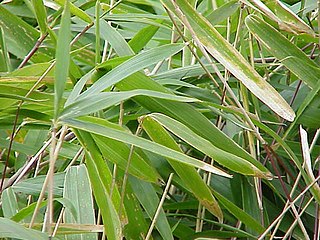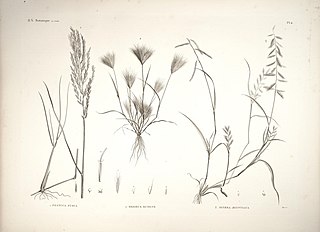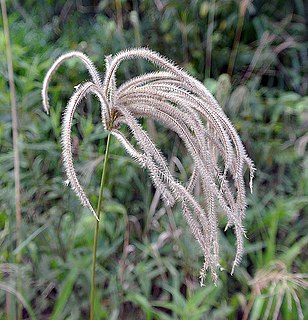
Pennisetum is a widespread genus of plants in the grass family, native to tropical and warm temperate regions of the world. They are known commonly as fountaingrasses. Pennisetum is considered a synonym of Cenchrus in Kew's Plants of the World Online.

Chloridoideae is one of the largest subfamilies of grasses, with roughly 150 genera and 1,600 species, mainly found in arid tropical or subtropical grasslands. Within the PACMAD clade, their sister group are the Danthonioideae. The subfamily includes widespread weeds such as Bermuda grass or goosegrass, but also millet species grown in some tropical regions, namely finger millet and teff.

Arundinarieae is a tribe of bamboo in the grass family (Poaceae) containing a single subtribe, Arundinariinae, and 31 genera. These woody bamboos occur in areas with warm temperate climates in southeastern North America, Subsaharan Africa, South Asia and East Asia. The tribe forms a lineage independent of the tropical woody bamboos (Bambuseae) and the tropical herbaceous bamboos (Olyreae).

Sporobolus is a nearly cosmopolitan genus of plants in the grass family. The name Sporobolus means "seed-thrower", and is derived from Ancient Greek word σπόρος (spóros), meaning "seed", and the root of βάλλειν (bállein) "to throw", referring to the dispersion of seeds. Members of the genus are usually called dropseeds or sacaton grasses. They are typical prairie and savanna plants, occurring in other types of open habitat in warmer climates. At least one species is threatened with extinction, and another is extinct.
Farrago is a genus of African plants in the grass family.

Calamovilfa is a genus of North American plants in the grass family native to the United States and Canada.

Cladoraphis is a genus of African plants in the grass family, native to southern Africa. Its phylogenetic position within the subfamily has not yet been resolved.
Coelachyrum is a genus of Asian and African plants in the grass family.
Craspedorhachis is a genus of African plants in the grass family.
Dignathia is a genus of African and Asian plants in the grass family.

Dinebra is a genus of Asian, African, and Pacific Island plants in the grass family.
Leptocarydion is a genus of African and Arabic plants in the grass family.

Leptochloa is a widespread genus of Asian, African, Australian, and American plants in the grass family.

Mosdenia is a genus of African plants in the grass family. The only known species is Mosdenia leptostachys, native to Angola and Limpopo.

Sporobolus foliosus is a species of grass known by the common name California cordgrass. It was reclassified from Spartina foliosa after a taxonomic revision in 2014. It is native to the salt marshes and mudflats of coastal California and Baja California, especially San Francisco Bay. It is a perennial grass growing from short rhizomes. It produces single stems or clumps of thick, fleshy stems that grow up to 1.5 meters tall. They are green or purple-tinged. The long, narrow leaves are flat or rolled inward. The inflorescence is a narrow, dense, spike-like stick of branches appressed together, the unit reaching up to 25 centimeters long. The lower spikelets are sometimes enclosed in the basal sheaths of upper leaves.

Danthonioideae is a mainly southern hemisphere subfamily of grasses, containing the single tribe Danthonieae and one unplaced genus, with altogether roughly 300 species. It includes herbaceous to partially woody perennial or annual (less common) grasses that grow in open grasslands, shrublands, and woodlands. It belongs to the PACMAD clade of grasses, but unlike some other lineages in that clade, grasses in the Danthonioideae exclusively use the C3 photosynthetic pathway. Its sister group is the subfamily Chloridoideae.

The PACMAD clade (previously PACCMAD, PACCAD, or PACC) is one of two major lineages (or clades) of the true grasses (Poaceae), regrouping six subfamilies and about 5700 species, more than half of all true grasses. Its sister group is the BOP clade. The PACMAD lineage is the only group within the grasses in which the C4 photosynthesis pathway has evolved; studies have shown that this happened independently multiple times.
Disakisperma is a genus of plants in the grass family, native to North and South America, Africa, and the Arabian Peninsula.

Stapfochloa is a genus of grasses. It is also in the subfamily Chloridoideae, and the Cynodonteae tribe.

Cynodonteae is a large tribe of grasses in the subfamily Chloridoideae, with over 800 species.













